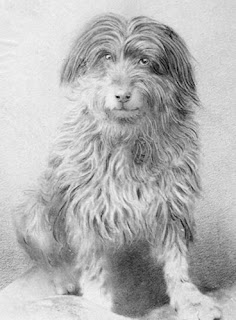Bob became famous in history as the free spirited dog who loved to travel on trains in Australia during the late 1800s.
According to William Seth Ferry, the first time he saw the scruffy mixed breed puppy was in a cattle truck at Terowie (where he was a special guard with the railway) with about 50 other stray dogs from Adelaide who were destined to become rabbit hunters. Ferry took a fancy to the pup and offered to buy him from the rabbiter. Several sources say the rabbiter refused to sell him but said he would swap him for another dog so Ferry found a stray dog loitering by a police station and made the swap. However, according to Olwyn Parker, author of The Railway Dog, Ferry paid five bob for the puppy, hence he got his name.
For five years Bob lived with Ferry, first in Terowie then in Petersburg (now Peterborough). He followed Ferry to work and rode with him in the guard's van, sometimes in the engine car, traveling thousands of miles around the South Australian countryside. Bob eventually became a free spirit, hopping on trains by himself, so when Ferry was promoted to Assistant Station Master in Western Australia in 1889 he decided to leave the adventurous dog behind with the railway men.
Bob traveled far and wide but he would always come back to his home base around Petersburg. He loved riding the trains, his favorite seat being on top of the coal box, and he loved the men that worked on them. At night, Bob would follow one of the railway workers, usually the driver, to his home where he would be fed and looked after. Bob was a real charmer and became well known in the towns he passed through - the sight of a dog on top of the coal fender brought much joy to adults and children alike.
 |
| Bob lying on top of the train |
In 1939, The Advertiser said Bob traveled freely "like politicians" on the trains, suburban trams and even the Murray steamers, and attended official functions: "He was a guest at the banquet for the opening of the railway from Peterborough to Broken Hill and appeared at the opening of the Hawkesbury Bridge in New South Wales."
Bob was well-liked by the travelers and the children adored him. The kind-hearted dog made many friends during his travels and even helped, at least one man, during a difficult time. Bob sat next to the man, Thomas McMurtrie, who was lost in grief after the death of his daughter-in-law and five grandchildren in a diphtheria outbreak. Parker wrote in her book "The man gave little sign of having noticed the dog’s presence, except once or twice when his hand came down and rested gently on Bob’s head - just for a moment, but the comfort was mutual ... This dog, though he’d never know it, had saved his sanity these past long hours."
In 1892, Bob disappeared for four months. He was taken by a sheep farmer and it is not sure if Bob escaped or was seen by one of the railway men. Parker thinks he was spotted when he came into town with a mob of sheep and the railway men angrily took back their dog from the sheep farmer. After this incident one of Bob's friends, a commercial traveler, had a special collar made for him with the following inscription: STOP ME NOT BUT LET ME JOG FOR I AM BOB THE DRIVERS DOG - SAR (South Australian Railways).
Bob died in 1895 at the approximate age of 13 years. His collar is on display in the National Railway Museum in Port Adelaide and in 2009 the people in Peterborough and wider South Australia raised funds for a statue of Bob.



